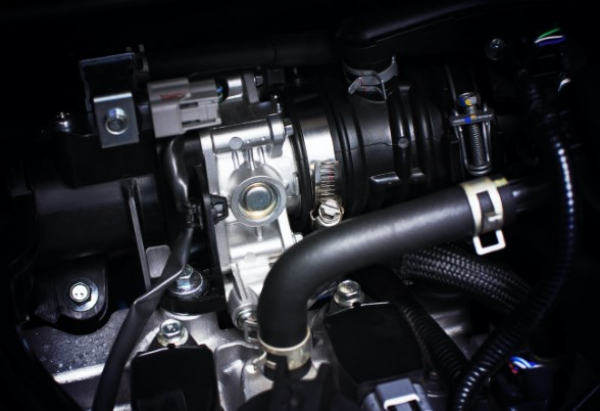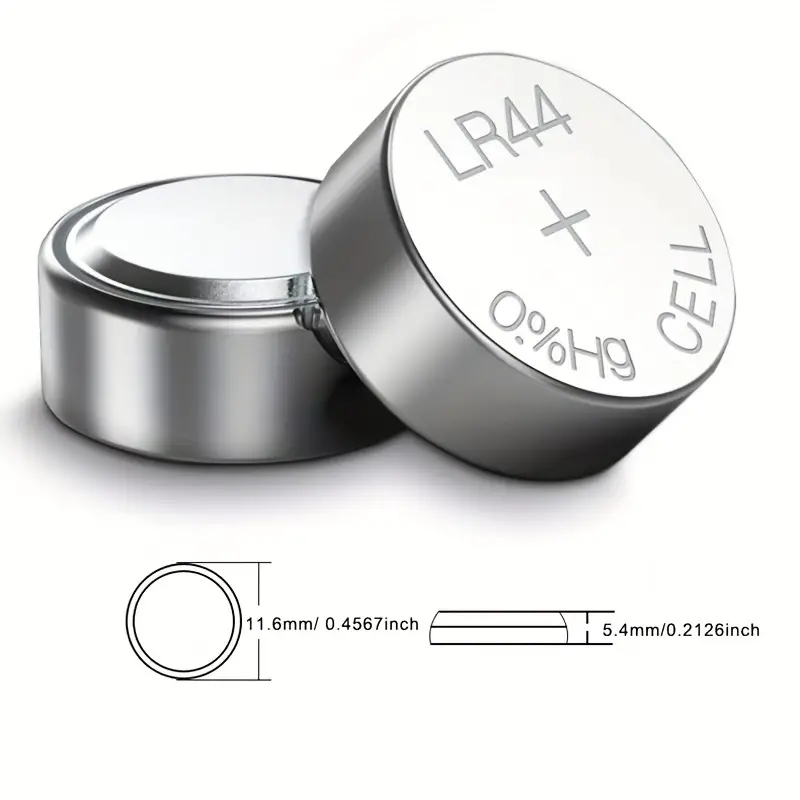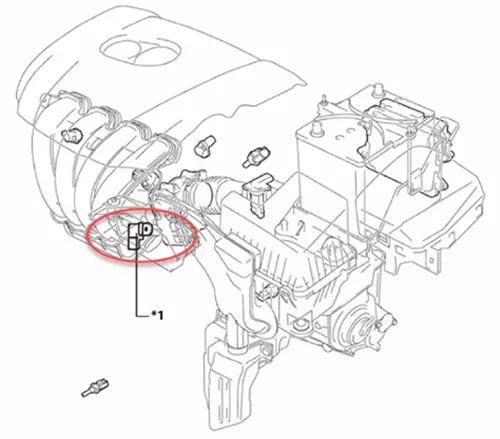A Throttle Pedal Position Sensor Switch A Circuit is a specific diagnostic trouble code (DTC) that indicates an issue related to the input signal from the throttle pedal position sensor or accelerator pedal position sensor in a vehicle. This code is typically associated with electronic throttle control systems, where the position of the accelerator pedal is electronically monitored and used to control the throttle opening in the engine.

Here's what the term typically means:
-
Throttle Pedal Position Sensor: The throttle pedal position sensor, also known as the accelerator pedal position sensor, is a sensor that detects the position of the accelerator pedal. It provides important input to the engine control module (ECM) regarding how much the driver is pressing on the accelerator pedal.
-
Switch A Circuit: In the context of the diagnostic trouble code, "Switch A Circuit" refers to a specific circuit or component related to the throttle pedal position sensor. This part of the sensor circuitry may be responsible for sending specific signals or data related to the pedal position.
When the ECM detects an issue with the input signal from the throttle pedal position sensor or the related circuit (Switch A Circuit), it triggers the Throttle Pedal Position Sensor Switch A Circuit DTC. This could indicate problems such as:
- Faulty Sensor: The sensor itself may be malfunctioning or sending incorrect signals.
- Wiring Issues: Wiring harness problems, such as shorts, breaks, or poor connections, can disrupt the signal between the sensor and the ECM.
- Connector Problems: Issues with the electrical connectors that link the sensor to the vehicle's electrical system can also cause this error code.
- ECM Malfunction: In some cases, the ECM itself may be malfunctioning and not accurately interpreting the signals from the sensor.
When this error code is triggered, it is essential to diagnose and address the underlying issue promptly to ensure proper operation of the throttle control system and overall vehicle performance. Consulting a qualified mechanic or technician is recommended to properly diagnose and resolve the Throttle Pedal Position Sensor Switch A Circuit fault.
Where is the Throttle Pedal Position Sensor Switch A Circuit
The Throttle Pedal Position Sensor (TPPS) is typically located inside the vehicle's cabin, attached to the accelerator pedal assembly. This sensor measures the position of the accelerator pedal and sends this data to the Engine Control Module (ECM) or Powertrain Control Module (PCM). The Throttle Pedal Position Sensor Switch A Circuit fault code typically pertains to a specific circuit related to this sensor.
Here are the general steps to locate the Throttle Pedal Position Sensor and its associated circuits:
-
Locate the Accelerator Pedal: The accelerator pedal is typically located on the driver's side, near the floor of the vehicle. The Throttle Pedal Position Sensor is part of the accelerator pedal assembly.
-
Follow the Wiring Harness: To locate the specific circuit related to Throttle Pedal Position Sensor Switch A, you will need to follow the wiring harness connected to the accelerator pedal. The circuit may run through the vehicle's interior and connect to the ECM or PCM.
-
Check Service Manual or Wiring Diagram: Consult the vehicle's service manual or wiring diagram to identify the specific wires and connectors associated with the Throttle Pedal Position Sensor Switch A Circuit. This will help you trace the circuit accurately.
-
Inspect the Wiring Connections: Once you have located the wiring associated with the Throttle Pedal Position Sensor, inspect the wiring connections for any visible signs of damage, corrosion, or poor connections.
-
Test the Sensor: If you suspect an issue with the Throttle Pedal Position Sensor Switch A Circuit, you may need to perform diagnostic tests on the sensor itself. This can involve using a multimeter to check the sensor's resistance and output signal.
-
Consult a Professional: If you are unsure about locating or diagnosing the Throttle Pedal Position Sensor or the associated circuit, it is advisable to seek assistance from a qualified mechanic or technician. They will have the expertise and the necessary tools to diagnose and repair the issue effectively.
By following these steps and consulting the vehicle's documentation, you can locate the Throttle Pedal Position Sensor Switch A Circuit and address any issues affecting its operation within the vehicle.

What are the Symptoms of a Faulty Throttle Pedal Position Sensor Switch
A faulty Throttle Pedal Position Sensor Switch can lead to various issues with the vehicle's acceleration and performance. Here are some common symptoms that may indicate a problem with the Throttle Pedal Position Sensor Switch:
-
Unresponsive Accelerator Pedal:
- One of the key signs of a faulty Throttle Pedal Position Sensor Switch is an unresponsive accelerator pedal. You may press the pedal, but the vehicle does not accelerate as expected or responds intermittently.
-
Reduced Engine Power:
- A malfunctioning Throttle Pedal Position Sensor Switch can cause a decrease in engine power, leading to sluggish acceleration and overall reduced performance.
-
Engine Stalling or Idle Surges:
- Erratic engine idling, surging, or stalling can occur when the Throttle Pedal Position Sensor Switch is not functioning correctly. The engine may struggle to maintain a consistent idle speed.
-
Inconsistent Acceleration:
- The vehicle may exhibit inconsistent acceleration patterns, such as sudden surges or hesitations when pressing the accelerator pedal due to inaccurate signals from the sensor switch.
-
Check Engine Light:
- If the Throttle Pedal Position Sensor Switch is malfunctioning, it may trigger the Check Engine Light on the dashboard. This serves as an indicator to the driver that there is a problem with the sensor or its associated circuit.
-
Poor Fuel Efficiency:
- A faulty sensor switch can disrupt the fuel-air mixture ratio, leading to decreased fuel efficiency and increased fuel consumption as the engine struggles to operate efficiently.
-
Harsh Shifting:
- In vehicles with automatic transmissions, a faulty Throttle Pedal Position Sensor Switch can cause harsh or delayed gear shifts as the transmission tries to adapt to the inconsistent throttle input.
-
Limp Mode Activation:
- Some vehicles have a fail-safe mode known as "limp mode" that is activated when the Throttle Pedal Position Sensor Switch malfunctions. In this mode, the vehicle limits performance to protect the engine.
-
Electrical Issues:
- Other electrical issues such as erratic dashboard instrument readings or unusual behavior of other electronic components may also be linked to a faulty Throttle Pedal Position Sensor Switch.
If you experience any of these symptoms, it is recommended to have the vehicle inspected by a qualified mechanic. They can diagnose the issue with the Throttle Pedal Position Sensor Switch and perform any necessary repairs or replacements to restore proper throttle operation and overall vehicle performance.
What Happens When Throttle Pedal Position Sensor Goes Bad
When a throttle pedal position sensor goes bad, it can cause a variety of issues that affect the performance, drivability, and overall operation of the vehicle. Here are some common problems that can occur when the throttle pedal position sensor malfunctions:
-
Unresponsive Acceleration: A bad throttle pedal position sensor can cause the engine to be unresponsive to pressing the accelerator pedal. This can lead to delayed acceleration or a lack of power when trying to speed up.
-
Stalling or Surging: The sensor's failure can result in erratic engine behavior, including stalling when coming to a stop or surging while driving at a constant speed. These issues can make driving unpredictable and potentially unsafe.
-
Inconsistent Engine Performance: A faulty sensor can cause the engine to run inconsistently, leading to rough idling, uneven power delivery, and overall poor performance.
-
Check Engine Light: A malfunctioning throttle pedal position sensor is likely to trigger the Check Engine Light on the dashboard. This warning light indicates that the vehicle's onboard diagnostic system has detected a problem with a component like the sensor.
-
Acceleration Issues: Problems with the throttle pedal position sensor can result in acceleration issues, such as sudden acceleration, hesitation, or jerking while driving. These issues can make driving the vehicle challenging and less smooth.
-
Reduced Fuel Efficiency: A bad sensor can cause incorrect signals to be sent to the engine control module, leading to an imbalanced air-fuel mixture. This inefficiency can reduce fuel economy, causing the vehicle to consume more fuel than usual.
-
Transmission Problems: In vehicles with automatic transmissions, a failing throttle pedal position sensor can lead to harsh or delayed shifting, as the transmission attempts to adjust to the erratic throttle inputs.
-
Limp Mode Activation: In some cases, a vehicle may go into limp mode when the throttle pedal position sensor malfunctions. Limp mode restricts the vehicle's speed and performance to prevent further damage and protect the engine.
If you suspect that your throttle pedal position sensor is faulty based on these symptoms, it is essential to have it inspected and repaired by a qualified mechanic. Ignoring issues with the sensor can lead to more serious problems and potentially unsafe driving conditions.
How to Diagnose a Faulty Throttle Pedal Position Sensor Switch
Diagnosing a faulty throttle pedal position sensor switch involves a series of steps to identify and confirm the issue. Here's a general guide on how to diagnose a faulty throttle pedal position sensor switch:
-
Scan for Diagnostic Trouble Codes (DTCs):
- Use an OBD-II scanner to check for any diagnostic trouble codes (DTCs) stored in the vehicle's computer system. If there is a problem with the throttle pedal position sensor switch, relevant codes such as P0120, P0121, P0122, or P0123 may be present.
-
Visual Inspection:
- Perform a visual inspection of the throttle pedal position sensor and its wiring harness. Look for signs of physical damage, corrosion, loose connections, or worn-out components that may indicate a problem.
-
Check Accelerator Pedal Response:
- Test the response of the accelerator pedal. Check for any delays, inconsistencies, or lack of response when pressing the pedal. Note any irregularities in the pedal's operation.
-
Use a Multimeter:
- If you have a multimeter, you can test the throttle pedal position sensor switch for proper voltage output. Consult the vehicle's service manual for the specific voltage values that should be present at different pedal positions.
-
Throttle Position Sensor Testing:
- Perform tests on the throttle pedal position sensor switch to ensure it is functioning correctly. This may involve checking the sensor's resistance or output voltage at different pedal positions using the multimeter.
-
Check for Wiring and Connector Issues:
- Inspect the wiring harness connected to the throttle pedal position sensor switch for any damage, breaks, or loose connections. Ensure that the wiring and connectors are in good condition and securely attached.
-
Functional Testing:
- Perform a functional test of the throttle pedal position sensor switch by monitoring the sensor's output while operating the accelerator pedal through its full range of motion. Verify that the sensor sends consistent and accurate signals to the vehicle's computer.
-
Consult Service Manual:
- Refer to the vehicle's service manual for diagnostic procedures specific to your make and model. Follow the manufacturer's guidelines for testing and diagnosing issues related to the throttle pedal position sensor switch.
-
Seek Professional Help:
- If you are unsure about diagnosing the issue yourself or lack the necessary tools, consider seeking assistance from a qualified mechanic or technician. They have the expertise and equipment to diagnose and repair throttle pedal position sensor switch problems accurately.
By following these steps and procedures, you can effectively diagnose a faulty throttle pedal position sensor switch and take the appropriate steps to address the issue and restore proper operation of the sensor and the vehicle.
How to Repair a Faulty Throttle Pedal Position Sensor Switch
Repairing a faulty throttle pedal position sensor switch typically involves either fixing the existing sensor or entirely replacing it with a new one. Here is a general guide on how to repair a faulty throttle pedal position sensor switch:
-
Disconnect the Battery:
- Before starting any repair work on the throttle pedal position sensor switch, disconnect the vehicle's battery to prevent any electrical mishaps.
-
Locate the Throttle Pedal Position Sensor Switch:
- Locate the throttle pedal position sensor switch on the accelerator pedal assembly inside the vehicle's cabin.
-
Inspect the Sensor:
- Inspect the sensor for any physical damage, corrosion, or visible signs of wear. Check the wiring harness and connectors for any issues.
-
Repair the Sensor (if possible):
- If the sensor is repairable and the issue is due to loose connections or minor damage, you may attempt to repair it by fixing the wiring, connectors, or any other visible problems.
-
Replace the Throttle Pedal Position Sensor Switch:
- If the throttle pedal position sensor switch is beyond repair or if you are unable to identify and fix the issue, you may need to replace the sensor with a new one. Follow these steps to replace the sensor:
- Purchase a Replacement Sensor: Obtain a new throttle pedal position sensor switch that is compatible with your vehicle's make and model.
- Installation: Install the new sensor in place of the old one on the accelerator pedal assembly. Ensure that all connections are secure and properly attached.
- Reconnect Wiring: Connect the wiring harness to the new sensor following the manufacturer's instructions or the vehicle's service manual.
- If the throttle pedal position sensor switch is beyond repair or if you are unable to identify and fix the issue, you may need to replace the sensor with a new one. Follow these steps to replace the sensor:
-
Reconnect the Battery:
- Once the repair or replacement is complete, reconnect the vehicle's battery to restore power.
-
Clear Diagnostic Trouble Codes:
- Use an OBD-II scanner to clear any stored diagnostic trouble codes related to the throttle pedal position sensor switch. This step will reset the vehicle's computer system and allow it to relearn the new sensor's parameters.
-
Test the Repair:
- Start the vehicle and test the accelerator pedal's response to ensure that the new sensor is functioning correctly. Check for any abnormal behavior or issues with acceleration.
-
Professional Assistance:
- If you encounter difficulties during the repair process or are unsure about replacing the sensor, consider seeking help from a qualified mechanic or technician to ensure the repair is done correctly.
By following these steps, you can effectively repair a faulty throttle pedal position sensor switch and restore proper operation of the sensor, ensuring optimal performance of the vehicle's throttle control system.
Question: Can You Replace Just the Throttle Position Sensor
In many vehicles, the throttle position sensor (TPS) is integrated into the throttle body assembly and cannot be replaced separately. However, in some cases, especially in older vehicles or vehicles with certain designs, it may be possible to replace just the throttle position sensor without replacing the entire throttle body assembly.
Here are some points to consider when determining if you can replace just the throttle position sensor:
-
Integrated vs. Separate Sensor:
- Modern vehicles often have integrated throttle position sensors that are part of the throttle body assembly. If the TPS is integrated, you will likely need to replace the entire throttle body assembly.
- In some older vehicles or specific designs, the TPS may be a separate component that can be replaced independently.
-
Availability of Parts:
- Check with your vehicle's manufacturer or a trusted parts supplier to see if the throttle position sensor is available as a separate component for your specific vehicle make and model.
-
Cost Consideration:
- Replacing just the throttle position sensor can be more cost-effective than replacing the entire throttle body assembly. If the sensor is available separately and the cost difference is significant, it may be worth considering.
-
Compatibility and Calibration:
- When replacing the throttle position sensor independently, ensure that the new sensor is compatible with your vehicle's system. Calibration and adjustment may be necessary to ensure proper functioning.
-
Professional Installation:
- If you are not familiar with automotive repairs or have limited experience working on vehicle components, it may be best to have a qualified mechanic or technician perform the replacement. They can ensure the new sensor is installed correctly and calibrated for optimal performance.
-
Diagnostic Confirmation:
- Before replacing the throttle position sensor, it is essential to diagnose the issue accurately to confirm that the sensor is faulty. Using diagnostic tools and techniques can help pinpoint the source of the problem and prevent unnecessary part replacements.
In conclusion, while it may be possible to replace just the throttle position sensor in some cases, it depends on the vehicle's design, the availability of separate sensor components, and other factors specific to your vehicle. If you are considering replacing the throttle position sensor independently, consult with a professional automotive technician or parts supplier to determine the best course of action for your particular situation.


